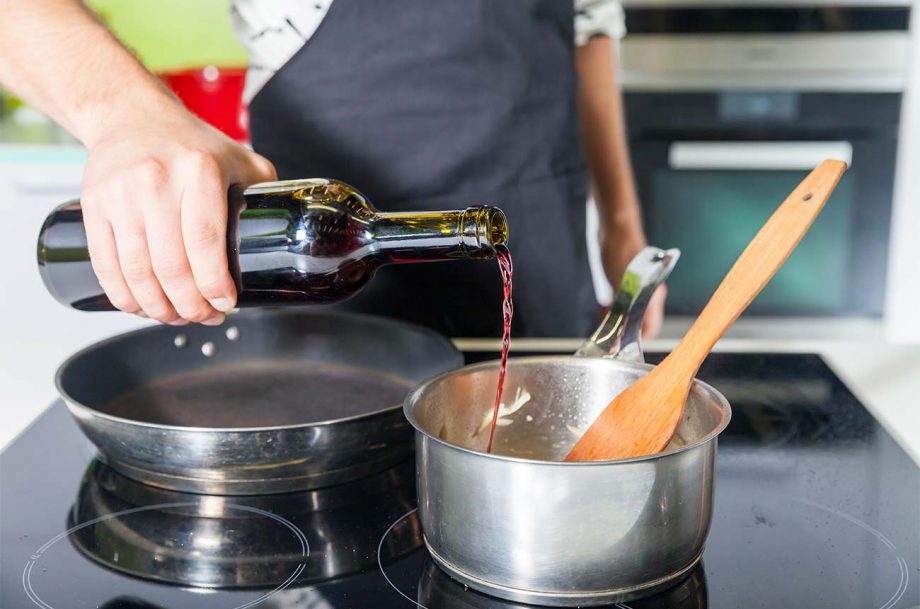We’ve all heard the saying, “Cook with wine you wouldn’t want to drink,” or, “The cheaper the wine, the better it is for cooking.” But seasoned home cooks and professional chefs sing a different tune, and we agree. If you don’t want to drink that bottle you got as a Christmas present, then you won’t like what it does to your food. Only cook with wines that you would drink, with a few exceptions, but we’ll get into that in a minute.
Wine is a wonderful addition to most recipes, especially those containing meat. Choosing the best wine might seem intimidating at first, but with our guide, you’ll quickly learn what to look for when buying a bottle and which types and varieties work well with what you’re cooking.
Myth buster: Cooking wine versus drinking wine
Throw out your preconceived notions of what constitutes cooking or drinking wine when selecting a bottle for your next recipe. What matters most is the flavour profile of the wine, less so the price tag, although there are two golden rules of thumb to keep in mind:
- There is a thing as ‘too cheap’. Avoid wines labelled ‘Cooking wine’ – they are usually poor quality and will diminish or overpower the dish, rather than enhancing it.
- No vintages or top-of-the-shelf bottles. It’s not that it will be a total waste of money (well, maybe a little), but the delicate flavours and tannins will be reduced to harsh, bitter flavours with the heat of cooking. Keep those for drinking, especially when celebrating with loved ones.
What happens to wine when you cook with wine
Firstly, don’t worry about the alcohol content. If done correctly, the alcohol content will burn off in the process (especially when you deglaze a pan or flambé just before serving). With the alcohol fully evaporated, the dish is safe for everyone to eat, including kids and those with dietary or religious constraints. So what happens to the rest of the wine during cooking?
The hot temperatures will bring out certain flavours, like fruitiness or tannins, while dulling others, think more delicate aromas and floral flavours – these aren’t intense enough to withstand the heat.
This is why choosing the best flavour profile is the most important step. Vintage wines, or the more pricey varieties, have been bottled and left to develop intricate, complex, and delicate flavours over many years. These will become flat, dull, or even worse, extremely bitter when exposed to high temperatures – thus, best to avoid. The same can be said for cheaper, lower-quality wines. Their flavour profiles are usually much harsher, more bitter or sour, and high temperatures will just exacerbate these, leaving you with an unpleasant-tasting dish.
Choose a flavour profile that is balanced (not too sweet, not too sour, and not too bitter), with punchy, hearty flavours (think fruity, full-bodied, spicy, etc.) that will withstand heat and blend well with the other ingredients of the dish.
Ideas for using wine in cooking
White wine
- White wines pair beautifully with light, fragrant, and vibrant dishes and sauces.
- Use your favourite dry white with oily, light fish, seafood and risottos.
- Use a slightly sweeter variety for roasted dishes (with light meats like fish, poultry and seafood), vegetables, braises, and hearty pastas.
- Don’t forget dessert: A splash of sweet white with poached fruit, self-saucing puddings, and compotes will add that little something extra, making dessert irresistible.
Red wine
- Recent studies have shown that red wine is a wonderful addition to marinades, tenderising and somewhat disinfecting meats. Splash a robust, full-bodied red into your next marinade and taste the magic.
- Use lower, gentler heat on reds to avoid overly bitter flavours.
- Reduce a slightly sweeter red wine with equal amounts of stock for a luxurious, complex-tasting jus.
- Use your favourite red for deglazing the pan after searing red and dark meats (beef, lamb, venison, duck, and some cuts of pork).
- Reduce ultra-sweet reds on their own to make a deliciously sticky glaze you can use as a finishing touch for a meaty, umami dish, or add to salads for a vibrant kick.
- Super sweet, fortified reds pair beautifully with poached fruits for dessert.
Many delicious options are waiting for the right bottle of wine. Trust your gut, cook with your favourites, and have a ball experimenting!

